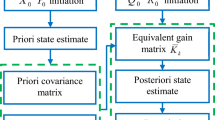Abstract
Differential carrier phase observations from GPS (Global Positioning System) integrated with high-rate sensor measurements, such as those from an inertial navigation system (INS) or an inertial measurement unit (IMU), in a tightly coupled approach can guarantee continuous and precise geo-location information by bridging short outages in GPS and providing a solution even when less than four satellites are visible. However, to be efficient, the integration requires precise knowledge of the lever arm, i.e. the position vector of the GPS antenna relative to the IMU. A previously determined lever arm by direct measurement is not always available in real applications; therefore, an efficient automatic estimation method can be very useful. We propose a new hybrid derivative-free extended Kalman filter for the estimation of the unknown lever arm in tightly coupled GPS/INS integration. The new approach takes advantage of both the linear time propagation of the Kalman filter and the nonlinear measurement propagation of the derivative-free extended Kalman filter. Compared to the unscented Kalman filter, which in recent years is typically used as a superior alternative to the extended Kalman filter for nonlinear estimation, the virtue of the new Kalman filter is equal estimation accuracy at a significantly reduced computational burden. The performance of the new lever arm estimation method is assessed with simulated and real data. Simulations show that the proposed technique can estimate the unknown lever arm correctly provided that maneuvers with attitude changes are performed during initialization. Field test results confirm the effectiveness of the new method.










Similar content being viewed by others
References
Farrell J (2008) Aided navigation: GPS with high rate sensors. McGraw-Hill Professional Publishing, USA
Hong S, Lee MH, Kwon SH, Chun HH (2004) A car test for the estimation of GPS/INS Alignment errors. IEEE Trans Intell Transp Syst 5(3)
Hong S, Lee MH, Chun HH, Kwon SH, Speyer JL (2005) Observability of error states in GPS/INS integration. IEEE Trans Veh Technol 54(2)
Hong S, Lee MH, Chun HH, Kwon SH, Speyer JL (2006) Experimental study on the estimation of lever arm in GPS/INS. IEEE Trans Veh Technol 55(2)
Julier S, Uhlmann J (2004) Unscented filtering and nonlinear estimation. In: Proceedings of the IEEE, vol 92, no. 3
Kalman R (1960) A new approach to linear filtering and prediction problems. Trans ASME J Basic Eng 82(Series D):35–45
Li Y, Rizos C, Wang JL (2008) Sigma-point Kalman filtering for tightly coupled GPS/INS integration. Navigation 55(3)
Quine M (2006) A derivative-free implementation of the extended Kalman filter. Automatica 42:1927–1934
Seo J, Leen HK, Lee JG, Park CG (2006) Lever arm computation for GPS/INS/Odometer integrated system. Int J Control Autom Syst 4(2)
Acknowledgment
Richard Deurloo is supported by a Ph.D. grant (SFRH/BD/25618/2005) from the Fundação para a Ciência e Tecnologia (FCT). This funding is gratefully acknowledged.
Author information
Authors and Affiliations
Corresponding author
Appendix: Computation loads of EKF, UKF and HDEKF
Appendix: Computation loads of EKF, UKF and HDEKF
Based on the algorithms given in this paper, the computation operations of the EKF, UKF, and HDEKF are listed in Table 6. The numbers of operations of EKF and UKF are from Li et al. (2008).
For the system described here, which has 18 states in system equations and uses four visible satellites, the total computational loads of the three nonlinear Kalman filters used in the estimation of the lever arm are listed in Table 7.
As can be seen from Tables 6 and 7, the UKF has the highest computational load, especially in the square-root operation, which is one of the most demanding operations in machine computation. This indicates that the UKF is not suitable for use in real-time applications. However, the HDEKF has a much lower computation load than the UKF method. Furthermore, the proposed algorithm has the lowest loads in the addition and multiplication operations.
Rights and permissions
About this article
Cite this article
Geng, Y., Deurloo, R. & Bastos, L. Hybrid derivative-free extended Kalman filter for unknown lever arm estimation in tightly coupled DGPS/INS integration. GPS Solut 15, 181–191 (2011). https://doi.org/10.1007/s10291-010-0190-8
Received:
Accepted:
Published:
Issue Date:
DOI: https://doi.org/10.1007/s10291-010-0190-8




